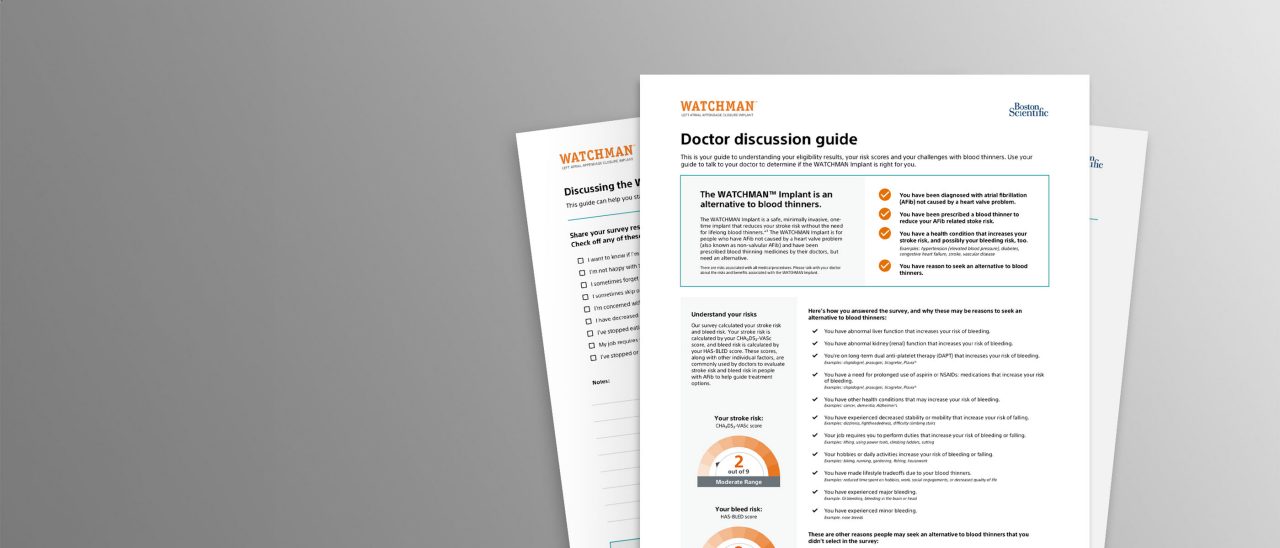Find out the next steps to living life free from lifelong blood thinners and the worry that comes along with them.
The WATCHMAN Implant difference
The WATCHMAN Implant is a one-time, minimally invasive implant to reduce stroke risk for peoplewith non-valvular AFib (NV-AFib), or AFib not caused by a heart valve problem. The WATCHMANImplant device doesn’t have the same bleeding risks associated with the long-term use of bloodthinners.2 Patients can get back to life as usual with the WATCHMAN Implant, since there arevirtually no long-term restrictions after the procedure.
There are risks associated with all medical procedures. Please talk with your doctor about the risksand benefits of the WATCHMAN Implant.
Freedom from blood thinners
96% of people stopped blood thinners 45 days after their procedure*1
A safe procedure
High implant success rate of 99%** and a low major complication rate of 0.5%†1
Proven safety record
Over 20 years of clinical and real-world experience, over 10 clinical studies and over 600,000 people treated
The WATCHMAN Implant is the #1 doctor recommended, most implanted device for left atrial appendage closure.

Benefits of the WATCHMAN Implant vs. long-term blood thinners
Safe, minimally-invasive, one-time, permanent implant
Reduces stroke risk without lifelong blood thinner medications
Freedom from lifestyle limitations due to blood thinner challenges and the worry that comes along with them

Proven safety record
600,000+ WATCHMAN devices implanted worldwide
Over 20 years of clinical and real-world experience – including over 10 clinical trials
High implant success rate of 99%** and a low major complication rate of 0.5%†1
Approved by the U.S. Food and Drug Administration (FDA) for reducing the risk of stroke in people with AFib not caused by a heart valve problem
As with any medical procedure, there are risks involved with the WATCHMAN Implant. Review the Important Safety Information for a list of possible complications, and ask your doctor about the risks and benefits of the WATCHMAN Implant.

Who can benefit from the WATCHMAN Implant?
The WATCHMAN Implant may be right for you if you have non-valvular atrial fibrillation (AFib), and:
You have a job, hobby, or health concern that puts you at risk for serious bleeding
You’ve experienced bleeding in the past due to blood thinners
You have difficulty taking blood thinners as prescribed by your doctor
Due to the risks of having a medical procedure, patients should not be considered for the WATCHMAN Implant if they are doing well and expect to continue doing well on blood thinners.
Is the WATCHMAN Implant safe?
Dr. Abisogun, a specialist who performs the WATCHMAN Implant procedure, explains what makes it safe.
Why Daniel chose the WATCHMAN Implant
Daniel's bleeding risks on blood thinners were keeping him from doing the things he loved.
Talk with your doctor
If you have atrial fibrillation not caused by a heart valve problem and you’re looking for an alternative to blood thinners, then it’s important to talk to your doctor about your options.
Recommended questions you can ask:
What are the benefits and risks of the different blood thinners?
What are the benefits and risks of the WATCHMAN Implant?
Does my lifestyle or health history put me at risk for serious bleeding?
Am I a candidate for the WATCHMAN Implant?
What should I know about the WATCHMAN Implant?
What are the differences in cost between blood thinners and the WATCHMAN Implant?
Tell your doctor about any falls or accidents, unusual bruising, or symptoms of bleeding that you’ve had while on blood thinners. And be sure to ask about the benefits and risks associated with the WATCHMAN Implant.
Already took the quiz? Return to your personalized experience.

Connect with a WATCHMAN Ambassador
WATCHMAN Ambassadors are people who have received the WATCHMAN Implant and have volunteered to share their experience. You can ask them about their experiences on blood thinners, why they chose the WATCHMAN Implant, what life is like after the procedure, and more. Our education team can connect you. Contact us to learn more:
Next steps
*In a clinical trial, 96% of patients were able to discontinue their blood thinner 45 days after getting the WATCHMAN Implant.
**Procedure success defined as successful delivery and release of a WATCHMAN FLX device into the LAA.
† In a post-FDA approval analysis. Major complication is defined as an occurrence of one of the following events between the time of implant and within 7 days following the procedure or by hospital discharge, whichever is later: all-cause death, ischemic stroke, systemic embolism, or device or procedure related events requiring open cardiac surgery or major endovascular intervention.
References:
1. Kar, S., et al, Primary Outcome Evaluation of the Next Generation LAAC Device: Results from the PINNACLE FLX Trial, Circulation, 2021.
2. Price MJ, Reddy VY, Valderrábano M, et al. Bleeding outcomes after left atrial appendage closure compared with long-term warfarin. JACC Cardiovasc Interv. 2015;8(15):1925-1932.
All images are the property of Boston Scientific. All trademarks are the property of their respective owners.
Content on this web page is for Informational Purposes only and does not constitute medical advice and should not be used for medical diagnoses. Boston Scientific strongly recommends that you consult with your physician on all matters pertaining to your health or to address any clinical/medical questions.
Important Safety Information
The WATCHMAN FLX and WATCHMAN FLX Pro Devices are permanent implants designed to close the left atrial appendage in the heart in an effort to reduce the risk of stroke.
With all medical procedures there are risks associated with the implant procedure and the use of the device. The risks include, but are not limited to, accidental puncture of the heart causing fluid to collect around the heart possibly leading towards the need for an additional procedure, allergic reaction, anesthesia risks, altered mental status or confusion after procedure, arrhythmias (irregular heartbeats), bleeding or throat pain from the TEE (Trans Esophageal Echo) probe, chest pain/discomfort, congestive heart failure, renal failure, excessive bleeding, gastrointestinal bleeding, groin puncture bleed, bruising at the catheter insertion site, groin pain, anemia (reduced red blood cells requiring transfusion), hypotension, infection/pneumonia (example: in or around your heart or lungs), misplacement of the device, improper seal of the appendage or movement of device from appendage wall, clot formation on the device, blood clot or air bubbles in the lungs or other organs, stroke, transient ischemic attack (temporary stroke-like symptoms), cranial bleed (bleeding in or around your brain), thrombosis (blockage of a blood vessel or vein by a clot) and in rare cases death can occur.
Be sure to talk with your doctor so that you thoroughly understand all of the risks and benefits associated with the implantation of the device. SH-2109508-AA

